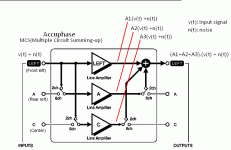Hi, I don´t understed how MCS (Multipli Circuit Summing-up) improve the S/N ratio or THD.
Accuphase Laboratory, Inc.?MCS
We get at the input v(t)+noise(t), 3 linears amps with gain A1, A2 and A3, then ouput is: (A1+A2+A3)*v(t) + (A1+A2+A3)*noise(t)
Or noise is not corralated and I can´t sum A1*noise(t)+A2*noise(t)+A3*noise(t)?
How improved the distorsion?
Accuphase Laboratory, Inc.?MCS
We get at the input v(t)+noise(t), 3 linears amps with gain A1, A2 and A3, then ouput is: (A1+A2+A3)*v(t) + (A1+A2+A3)*noise(t)
Or noise is not corralated and I can´t sum A1*noise(t)+A2*noise(t)+A3*noise(t)?
How improved the distorsion?
Attachments
You have a number of errors in your reasoning that come from not understanding some basic circuit rules.
Amplification factors do NOT sum unless amplifiers 1, 2, 3 are in series - NOT in parallel.
For the signals to simply add as is shown in this circuit, amplification factors of 1, 2, 3 MUST be the same, i.e. A1=A2=A3=A. The total amplification factor of such amps in parallel remains the same as that of a single amp, A.
A*noise(t) as well as distortion(t) are not correlated so they have to add as random vectors. Assuming noise(t) is of equal amplitude but not correlated between amplifiers 1, 2, 3, the total noise is noise(t)/(square root of 3), as is total THD.In reality, noise does behave as uncorrelated, distortion less so, so the drop in distortion is usually less than the theoretical 1/(square root of number of identical amps in parralel).
Amplification factors do NOT sum unless amplifiers 1, 2, 3 are in series - NOT in parallel.
For the signals to simply add as is shown in this circuit, amplification factors of 1, 2, 3 MUST be the same, i.e. A1=A2=A3=A. The total amplification factor of such amps in parallel remains the same as that of a single amp, A.
A*noise(t) as well as distortion(t) are not correlated so they have to add as random vectors. Assuming noise(t) is of equal amplitude but not correlated between amplifiers 1, 2, 3, the total noise is noise(t)/(square root of 3), as is total THD.In reality, noise does behave as uncorrelated, distortion less so, so the drop in distortion is usually less than the theoretical 1/(square root of number of identical amps in parralel).
Yep, very clear ilimzn, thanks.
Accuphase
Why use 2 input stage and not 2 transistor/FET in parallel?
What´s the crucial point?
Accuphase
The crucial point here is that circuits as a whole and not simply active components (such as transistors or FETs) are connected in parallel.
Why use 2 input stage and not 2 transistor/FET in parallel?
What´s the crucial point?
- Status
- This old topic is closed. If you want to reopen this topic, contact a moderator using the "Report Post" button.
